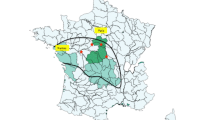Summary
Egg and liver samples of Montagu's and Marsh Harriers from the 1990's were examined for their burden of DDT and PCB. The DDT burden in both species was distinctly higher in the eggs than in juveniles and adults, whereby the values for the adults were clearly higher than those for the juveniles. The composition of the DDT isomers of both species varies between the life stages. In the egg samples nearly only p,p′-DDE was found, while in the livers of the adults and more especially of the juveniles higher parts of p,p′-DDT were detected. In both species the PCB burden of the eggs and of the adults was clearly higher than that of the juveniles. The composition of the PCB mixtures of both species differed distinctly between each of the life stages. While the PCB mixtures in eggs and in the livers of adults are nearly identical, in the livers of juveniles a distinct shift to lower chlorinated congeners reaching higher parts of the PCB mixtures becomes evident. The changes in the composition of DDT and PCB mixtures in the different life stages reflect a new uptake of these xenobiotics with the food animals.
Zusammenfassung
Ei- und Leberproben von Wiesen- und Rohrweihen aus den 1990er Jahren wurden auf ihre Belastung mit DDT und PCB untersucht. Die DDT Belastung der Eier überragt bei beiden Arten deutlich die Belastung der Jungvogel und der Adulten, wobei die Belastung der Adulten deutlich höher als die der Jungvögel ist. Wesentliche Unterschiede sind in der Zusammensetzung der DDT-Isomere in den Proben beider Arten ersichtlich. In den Eiproben findet sich fast nur p,p′-DDE, wdhrend in den Lebern der Adulten und besonders der Jungvögel auch ein erhöhter Anteil von p,p′-DDT zu finden ist. Bei beiden Arten lag die PCB-Belastung der Eier und der Adulten deutlich höher als die der Jungvögel. In der Zusammensetzung der PCB-Gemische beider Arten zeigen sich bezüglich der einzelnen Lebensstadien klare Unterschiede. Während die PCB-Gemische in den Eiern und in den Lebern der Adulten relativ identisch sind, tritt in den Lebern der Jungvögel eine deutliche Verschiebung zu niedrig chlorierten Kongeneren auf, die höhere prozentuale Anteile des Gemisches bilden. Aus den genannten Veränderungen der DDT- und PCB-Gemische lässt sich eine Aufnahme dieser Stoffe über die Nahrungstiere klar belegen.
Similar content being viewed by others
Literatur
Becker, P. H., Munoz Cifuentes, J., Behrends, B. & Schmieder, K. R. (2001): Contaminants in Bird Eggs in the Wadden Sea. Temporal and spatial trends 1991–2000. Wadden Sea Ecosystem No. 11, Common Wadden Sea Secretariat, Trilateral Monitoring and Assessment Group, Wilhelmshaven, Germany.
Becker, P. H. & Sommer, U. (1998): Die derzeitige Belastung der Flugßseeschwalbe Sterna hirundo mit Umweltchemikalien in Mitteleuropa. Vogelwelt 119: 243–249.
Beyerbach, M., Becker, P. H., Büthe, A., Denker, E., Heidmann, W. A. & Staats de Yanés, G. (1993): Variation von PCB-Gemischen in Eiern und Vögeln des Wattenmeeres. J. Ornithol. 134: 325–334.
Büthe, A. & E. Denker (1995): Qualitative and Quantitative Determination of PCB Congeners by Using a HT-5 GC Column and an Efficient Quadrupole MS. Chemosph. Vol. 30, No.4: 753–771.
Clarke, R. (1996): Montagu's Harrier. Chelmsford.
Conrad, B. (1976): Die Belastung der freilebenden Vogelwelt der Bundesrepublik Deutschland mit Chlorierten Kohlenwasserstoffen und PCB und deren mögliche Auswirkungen. Dissertation, Universität Köln.
Conrad, B. (1981): Zur Situation der Pestizidbelastung bei Greifvögeln und Eulen in der Bundesrepublik Deutschland. Ökol. Vögel 3: 161–167.
Cooke, A.S., Bell, A.A. & Haas, M.B. (1982): Predatory Birds, Pesticides and Pollution. Aberystwyth.
Denker, E. (1996): Untersuchungen zur PCB-Belastung verschiedener Trophiestufen in der Nordsee bei Helgoland unter besonderer Berücksichtigung der einzelnen PCB-Kongenere. Dissertation, Universität Hannover.
Denker, E. & Bathe, A. (1995): Organochlorine contamination and especially PCB contamination and pattern in Marsh Harriers (Circus aeruginosus) and Montagu's Harriers (Circus pygargus) from Northwest Germany. Abstr. Intern. Conf. Hol. Birds of Prey, Badajoz, Spanien, 108–109.
Dietrich, S., Bathe, A., Denker, E. & Hötker, H. (1997): Organochlorines in Eggs and Foof Organisms of Avocets (Recurvirostra avosetta). Bull. Environ. Contam. Toxicol. 58: 219–226.
Denker, E., Bathe, A., Knüwer, H., Langgemach, T., Lepom, P. & Rühling, I. (2001): Vergleich der Schadstoffbelastung in Eiern des Sperbers (Accipiter nisus) aus Brandenburg und NordrheinWestfalen, Deutschland. J. Ornithol. 142: 49–62.
DFG, Deutsche Forschungsgemeinschaft (1988): Polychlorierte Biphenyle. Weinheim.
Disser, J., Brunn, H., Nagel, A. & Prinzinger, R. (1992): Untersuchungen zur Belastung von Vogeleiem mit Chlorkohlenwasserstoffen unter besonderer Berücksichtigung der PCBs. Ökol. Vögel 14:173–209.
Heidmann, W.A. (1986): Isomer Specific Determination of Polychlorinated Biphenyls in Animal Tissues by Gas Chromatography Mass Spectrometry. Chromatographia 22: 363–369.
Mason, C.F., Ekins, G. & Ratford, J.R. (1997): PCB Congeners, DDE, Dieldrin and Mercury in eggs from an expanding colony of Cormorants (Phalacrocorax carbo). Chemosphere 34: 1845–1849.
May, R. & Ellenberg, H. (1985): Ein Freilandexperiment zur Ökologie der Schadstoffkontamination von Vögeln und Folgerungen für die Verwendung von Organismen als Biomonitoren. Okol. Vögel 7:97–112.
Newton, I. (1979): Population ecology of raptors. Berkhamsted.
Nygard, T. & Skaare, J.U. (1998): Organochlorines and Mercury in Eggs of White-tailed Sea Eagles Haliaeetus albicilla in Norway 1974–1994. In: Chancellor, R.D. & Meyburg, B.U. (eds.): Holarctic Birds of Prey, ADENEX-WWGBP: 501–524.
Presst, I., Jefferies, D.J. & Moore, N.W. (1970): Polychlorinated Biphenyls in Wild Birds in Britain and their Avian Toxicity. Environ. Poll. 1: 3–26.
Weber, M., Fieber, W. & Stubbe, M. (1998): Persistente chlororganische Verbindungen, Quecksilber und radioaktive Nuklide in Eiern von Rotmilanen (Milvus milvus) aus Sachsen-Anhalt. J. Ornithol. 139:141–147.
Author information
Authors and Affiliations
Rights and permissions
About this article
Cite this article
Denker, E., Büthe, A., Glimm, D. et al. Veränderungen in der Zusammensetzung der PCB- und DDT-Gemische in verschiedenen Lebensstadien der Wiesenweihe (Circus pygargus) und der Rohrweihe (Circus aeruginosus) in Nordrhein-Westfalen, Deutschland.. J Ornithol 144, 411–417 (2003). https://doi.org/10.1007/BF02465504
Accepted:
Published:
Issue Date:
DOI: https://doi.org/10.1007/BF02465504




